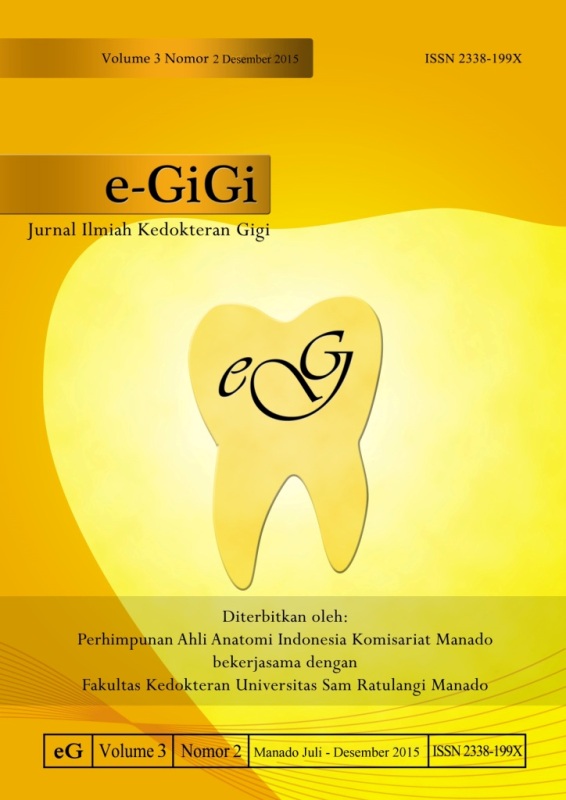UJI EFEKTIVITAS JAMBU BIJI MERAH (Psidium guajava) TERHADAP LAJU ALIRAN SALIVA PADA PENDERITA XEROSTOMIA YANG MENGONSUMSI TELMISARTAN
DOI:
https://doi.org/10.35790/eg.3.2.2015.9602Abstract
Abstract: A study done by National Center for Biotechnologi Information (NCBI) to the user of antihypertension drugs, 50% of the individuals are suffering xerosomia or dry mouth. The reduction of saliva because of xerostomia may increase the risk of tooth damage. Vitamin C contained in red guava (Psidium Guajava) is expected to induce salivary flow rate in Xerostomia patients who consume antihypertensive Telmisartan.The purpose of this study is to acknowledge the effect of red guava in increasing salivary flow rate in Xerosotmia patients who consume antihypertensive Telmisartan. This is a clinical trial study with nonequivalent control group experimental design. Each group has 15 samples from the population of hypertensive patients who consume antihypertensive Telmisartan and are suffering Xerostomia in Pancaran Kasih Hospital and Prof. Dr. RD. Kandou Hospital. The treatment group is given red guava fruit that is already served as pure juice while the control group is only given mineral water. Saliva is collected twice, that is before treatment and after treatment. Saliva is collected by spitting method and the salivary flow rate is measured by using disposable syringe with the measurement of ml/minute.The result of this study shows that the average of salivary flow rate before of control group is 0.23 ml/minute and the average of salivary flow rate after is 0.28 ml/minute. While the average of salivary flow rate before treatmen in treatment group is 0.24 ml/minute and the average of salivary flow rate after treatment is 0.83 ml/minute. It can be concluded that red guava has been proved to be effectively increase salivary flowrate of xerostomia patients who consume antihypertensive Telmisartan.
Keywords: xerostomia, red guava, salivary flow rate
Abstrak: Sebuah studi yang dilakukan oleh National Center for Biotechnology Information (NCBI) yang melakukan penelitian terhadap pengguna obat antihipertensi, sebanyak 50% menderita Xerostomia atau mulut kering. Laju aliran saliva yang menurun akibat Xerostomia dapat menyebabkan meningkatnya resiko kerusakan gigi. Kandungan vitamin C pada buah jambu biji merah (Psidium guajava) diharapkan dapat meningkatkan laju aliran saliva pada penderita xerostomia yang mengonsumsi obat antihipertensi golongan Telmisartan.Penelitian ini bertujuan untuk mengetahui efek jambu biji merah dalam meningkatkan laju aliran saliva pada penderita Xerostomia yang mengonsumsi Telmisartan. Penelitian ini adalah penelitian uji klinis dengan rancangan eksperimental nonequivalent control group design. Setiap kelompok beranggotakan 15 orang dari populasi pasien pengguna obat antihipertensi golongan Telmisartan yang menderita Xerostomia di RSU Pancaran Kasih dan RSUP Prof. DR. R. D. Kandou Malalayang. Kelompok perlakuan mengonsumsi buah jambu biji merah yang disajikan dalam bentuk jus murni sedangkan kelompok kontrol hanya mengonsumsi air mineral. Saliva dikumpulkan sebanyak dua kali yaitu sebelum dan sesudah mengonsumsi buah jambu biji merah. Saliva dikumpulkan dengan metode spitting dan laju aliran saliva diukur menggunakan disposable syringe dengan satuan ml/ menit.Hasil penelitian menunjukkan bahwa rerata laju aliran saliva awal pada kelompok kontrol yaitu 0,23 ml/menit dan laju aliran saliva akhir kelompok kontrol yaitu 0,28 ml/menit. Sedangkan rerata laju aliran saliva awal pada kelompok perlakuan yaitu 0,24 ml/menit dan laju aliran saliva akhir kelompok perlakuan yaitu 0,83 ml/menit. Dapat disimpulkan bahwa buah jambu biji merah dapat meningkatkan laju aliran saliva pada penderita Xerostomia yang mengonsumsi Telmisartan.
Kata kunci: xerostomia, jambu biji merah, laju aliran saliva.
Downloads
How to Cite
Issue
Section
License
COPYRIGHT
Authors who publish with this journal agree to the following terms:
Authors hold their copyright and grant this journal the privilege of first publication, with the work simultaneously licensed under a Creative Commons Attribution License that permits others to impart the work with an acknowledgment of the work's origin and initial publication by this journal.
Authors can enter into separate or additional contractual arrangements for the non-exclusive distribution of the journal's published version of the work (for example, post it to an institutional repository or publish it in a book), with an acknowledgment of its underlying publication in this journal.
Authors are permitted and encouraged to post their work online (for example, in institutional repositories or on their website) as it can lead to productive exchanges, as well as earlier and greater citation of the published work (See The Effect of Open Access).






